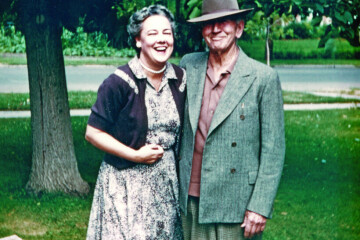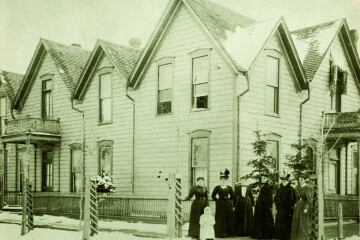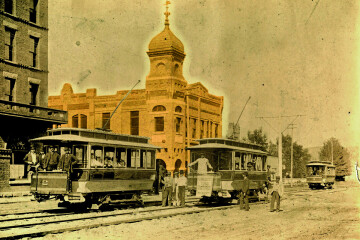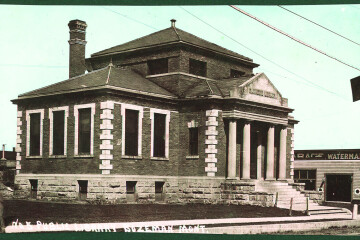Women of Bozeman’s Historic Northside
Bozeman’s north side has historically been the working-class side of town where the laborers and service workers lived, while the south side of Bozeman housed the capitalists, bankers, and business owners. The houses built on the north side reflect their working-class occupants, being small vernacular structures that held extended families consisting of often two and sometimes even three generations of family. Three women who lived on the north side from roughly 1890 to 1920 were Lizzie Kincade, Annie McLaughlin and Fannie Woodson. These three women were contemporaries and lived only blocks apart from one another, and likely knew each other, as Bozeman was a small town at that time. Lizzie, Annie, and Fannie don’t represent the collective history of women on the north side, but by learning about their lives, we can better understand life in early Bozeman through the lens of these three women.
Lizzie Todd was born and raised in Pennsylvania. She married John Kincade at a very young age, and they had three sons. At forty-three years old, Lizzie and her youngest son, William, who was seventeen, came to Bozeman around 1895, leaving husband John back in Philadelphia. Upon arrival in Bozeman, she represented herself as a widow—but her husband John, was still alive and well in Pennsylvania.
When Lizzie and son William first arrived in Bozeman, they rented a small wood-frame house on west Babcock Street (it has since been torn down, but was located where the Backcountry store parking lot is today, near the corner of Bozeman Avenue and Babcock Street). William worked as a teamster and Lizzie worked as a midwife. In 1902, one of Lizzie’s sisters died in Pennsylvania. This sister, Lottie, had never married, but had done very well for herself and was able to leave Lizzie $700 in her will. Most likely, it was with this money that Lizzie purchased a home in Bozeman at 201 N. Black, where Lizzie, William and his new wife and child set up house. This brick house was newly constructed by Andre J. Svorkmoe and Nels Baverly. Svorkmoe was a builder and contractor who built many homes on the south side of Bozeman, many of them of brick like this one. Svorkmoe and Baverly built this house for L. Reese Wells who, in turn, sold it to Lizzie for $500 according to the deed records.
Lizzie officially filed for divorce from John in 1905, citing physical abuse, alcohol abuse and desertion. This abuse and desertion was most likely the reason Lizzie left Philadelphia, taking her youngest son West with her.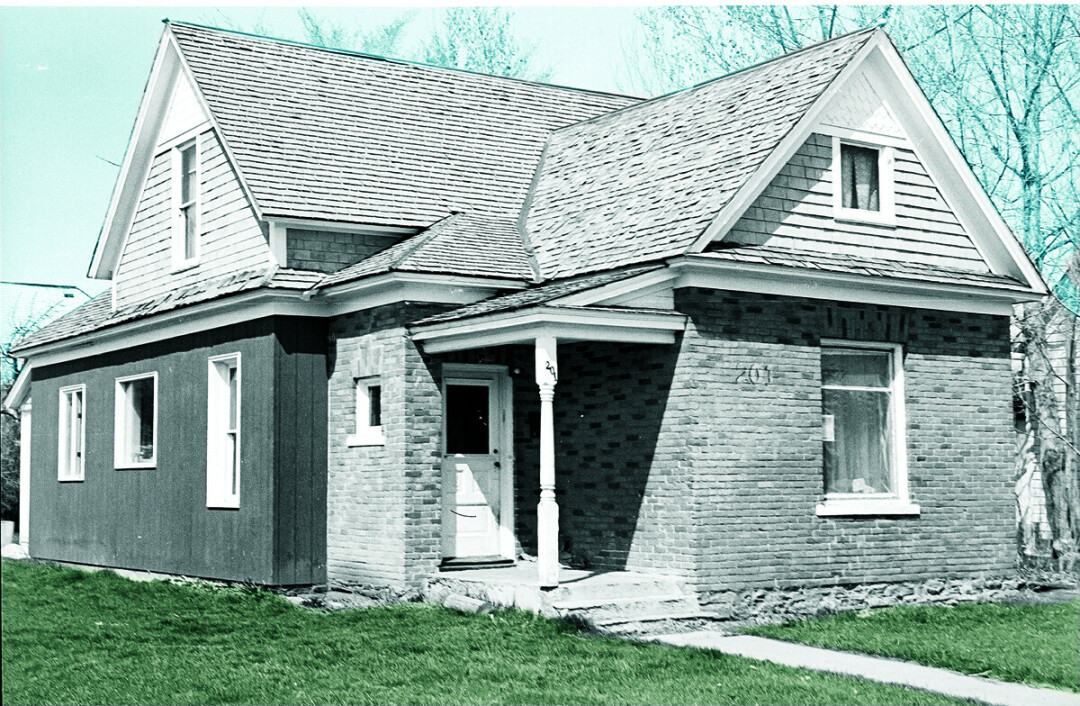
While living in this house, Lizzie continued to work as a midwife and later as a professional nurse. She took patients into her house to nurse them, as evidenced by the death certificate of prostitute Hattie Hayes. Hattie worked in Bozeman’s red-light district on east Mendenhall Street, just two blocks east and two blocks north of where Lizzie lived. Hattie died on February 7, 1908, at the age of twenty-nine. Her place of death was 201 N. Black, which was Lizzie’s residence. Just five years later, Lizzie also nursed Hattie’s sister, Libbie, in her last days. Libbie Hayes was the madam of a brothel on Mendenhall Street when she succumbed to uterine cancer at the age of thirty-four. The informant on the death certificate was Lizzie Kincade. Lizzie may have initially met the Hayes sisters due to her expertise in midwifery, which would have been important to women who worked in Bozeman’s red-light district. Lizzie Kincade sold her house to her sister, Sallie Bell, in 1922, then disappeared from the historical record.
Just one street over and one block up from Lizzie Kincade lived Annie McLaughlin at 302 N. Bozeman. Annie was born in Illinois in 1847. She moved to Bozeman between the late 1870s and the early 1880s. Upon her arrival in Bozeman, McLaughlin started a catholic school and tutored a few children in a building located on the corner of Bozeman Avenue and Lamme Street. “Interested in the education of Catholic children, she began St. Agnes Academy, held in a one-story frame dwelling . . . This school was held for only about seven years until it was disbanded and held elsewhere.” (Quoting Helen Ulrich from an interview in August of 1983). The Bozeman Weekly Chronicle also mentioned in June of 1884 that, “Miss McLaughlin, teacher of the Catholic school on Bozeman street north of Main, will take a few more scholars. Now that the public schools are closed, an opportunity is offered for tuition at low rates.”
McLaughlin moved to Butte for a time during the mid-1880s and worked in the Catholic School system there until she returned to Bozeman in 1887 and reopened the Catholic School she had previously operated. About this time, Annie purchased property on the corner of north Bozeman Avenue and Beall Street, where she had a residence built.
Annie never married; she provided for herself by running a boarding house out of her residence. In addition to the boarding house, she also took in laundry and raised cows and chickens, most likely selling eggs, butter, and possibly milk from the cows. The pasturing of her cows became problematic in 1900 when the neighbors complained that her cattle were running at large within the city limits, in disregard of the City of Bozeman Ordinance. When the authorities tried to enforce the ordinance, Annie McLaughlin resisted and was fined $5, which she refused to pay. The authorities had no choice but to put her in jail until she paid. Annie spent five days in jail before a relative paid the fine for her and she was released.
She lived in her house on north Bozeman Avenue until her death on March 15, 1922, of pneumonia. When she died, she owned her house and fifty chickens. A requiem high mass was celebrated by the local priest, Rev. Father Leitham, at the Holy Rosary Catholic church, of which McLaughlin had been a most faithful member. Her nephew, Joseph Meechan of Madison, South Dakota arrived shortly before her death and was the administrator of her estate. He then purchased the property after her estate was settled on August 24, 1922. Annie’s house still stands today at 302 N. Bozeman Avenue.
A more well-known resident of the northside was Fannie Woodson, a Black woman who was, like Lizzie Kincade, born in Pennsylvania in 1845. She came to Bozeman in 1872 as Fannie Taylor. Like Lizzie and Annie, we have no idea what brought her to Bozeman, but it was most likely the lure of opportunity, the possibility of work and the ability to purchase a home. Fannie soon met and married a Black man, George Woodson. Their daughter Clara was born in 1881. George Woodson worked for Nelson Story for a time, but then went on his own into the drayage or the short-distance transportation business, where he did quite well. He also opened a barber shop, but soon fell into debt, so he fled to Miles City. Fannie, worried about her husband, traveled to Miles City with Clara to find that he was living with another woman. The Bozeman Weekly Chronicle reported; “Mrs. Woodson sought her husband and accused him of infidelity, in answer to which he immediately sought recourse to the flowing bowl, having in the meantime armed himself to the teeth. Mrs. Woodson got him to her room in the hotel and, while he was sleeping off his drunken slumber, she cut his vest pocket open, abstracted his gold watch and chain, and took the next train for home, declaring that she never again will live with the man for whom she has toiled and slaved.” George never returned to Bozeman, nor to Fannie. She officially divorced him in 1903. Just prior to George’s departure, Fannie acquired a Sole Traders license from the City of Bozeman, which gave her the ability to work in her own name “to do laundry and ironing, and to buy and sell horses and to carry out any other kind of legitimate business.” In this document, she lists her capital as one-half interest in one sorrel mare, two barber chairs, one desk, one large mirror, one stove, and one eight-day clock. She may have acquired this license to protect herself and her profits from falling into the hands of her husband, George Woodson.
After George left Bozeman, Fannie lived in a house on East Mendenhall Street with her daughter, Clara. While living on Mendenhall Street, the census records list Fannie’s occupations as a day laborer in 1900, a housekeeper to a private family in 1910, and a nurse in 1920. She also operated her residence as a boarding house, with various numbers of boarders through the years. In 1904, Fannie married again, to Joseph Tucker. This marriage lasted until 1917 when Fannie filed for divorce, stating that Tucker had deserted and abandoned her. Fannie lived until 1920 when she succumbed to cervical cancer and dementia. Her obituary headline reads, “Well-Known Mammy Passes at Bozeman.” Fannie made an impression on Bozemanites, most likely due to her generous character as a nurse and caretaker. Her obituary made not only the Bozeman newspaper, but also the Billings Gazette and the Anaconda Standard.
By knowing more about Lizzie Kincade, Annie McLaughlin, and Fannie Woodson, we can better understand how women lived, worked and navigated life on Bozeman’s north side in the early 20th century. All three of these women owned their homes and worked hard to provide for themselves and their children, at least in the case of Lizzie and Fannie, as Annie never married, nor had children. The information provided above was gleaned in bits and pieces from deed records, newspaper accounts, death certificates, marriage certificates, city directories, and census records. These records give us a very cursory look at these women but, hopefully, as time goes on more information will come to light, helping us to make their lives more tangible.

